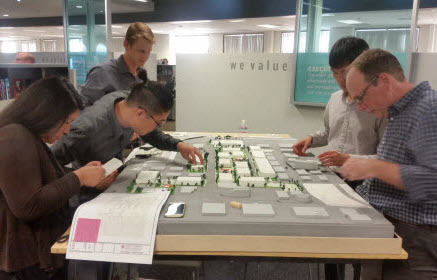How Integrated Design Streamlines the Decision-Making Process
Fri, Apr 22, 2016 Sara Flowers Sustainable Design, Integrated Design, Interdisciplinary Collaboration, Design Process
 Decisions. How many do you think are made throughout the course of a project? 10,000? 50,000? More? As designers, we make several decisions from the seemingly small—such as handrails and wall texture—to the more monumental—like mechanical systems and elevator types.
Decisions. How many do you think are made throughout the course of a project? 10,000? 50,000? More? As designers, we make several decisions from the seemingly small—such as handrails and wall texture—to the more monumental—like mechanical systems and elevator types.
Within each of the thousands of decisions there are dozens of additional selections to make and paths to follow. Should the finish for the handrails coordinate with the finish of the door and window frames? Brushed, satin or painted? Concealed or exposed fasteners? Gripping surface shape? Who is the prevalent user of the rails? Should they be mounted at a lower height to accommodate children? Should there be two sets of handrails?
While these decisions aren’t necessarily difficult, if they are made in a vacuum without buy in from the entire team, you might find yourself making considerable revisions late in the game. When making these decisions—from the small to the monumental—having an engage integrated design team of professionals working together on a day-to-day basis has proven to be a real benefit to our clients and their projects.
 Inviting all team members to gather together at the early stages of a project and collaborate to build a design strategy—one which includes the overall mission, establishes priorities, confirms performance targets and defines value—will help streamline all of those thousands of decisions that come later in the project. Once the entire design team is on board with the overall mission, they are better equipped to make meaningful decisions at every turn throughout the life of the project.
Inviting all team members to gather together at the early stages of a project and collaborate to build a design strategy—one which includes the overall mission, establishes priorities, confirms performance targets and defines value—will help streamline all of those thousands of decisions that come later in the project. Once the entire design team is on board with the overall mission, they are better equipped to make meaningful decisions at every turn throughout the life of the project.
Perhaps the most exciting aspect of the integrated design process at LPA is the potential for innovation. Team members of all areas, from interior design to engineering to landscape architecture, are encouraged to showcase both their proven expertise and their imaginative thoughts. The team leaders promote a culture where ideas are freely exchanged and allowed to be explored, debated and evaluated at the onset of a project and possibly incorporated into the design.
Right from the start, integrated design asks each core discipline, “how would you do it?" It is a process that takes this early input and informs the design, making the process linear and more efficient and therefore, contributes to LPA's sustainable design mission. Having this early input allows our teams to better communicate with owners, contractors and all members of the design team.
As the project design continues, it is imperative that the team continues to check in with one another along the way. Does everyone still have the mission at the center of their decision-making process? Is every option being challenged and is the team moving forward with only those options that best benefit the project? Is compromise necessary? If so, where is the team collectively willing to compromise?
There are several decisions to be made at every stage of a project. Having a team chocked full of smart, enthusiastic people who will help you make the best decisions early and stick to the mission of the project will reap the rewards of a job well done.
Sara Flowers, AIA, LEED AP BD+C, is an Associate at LPA and has overseen the completion of more than 20 projects, including corporate facilities and K-12 schools.
